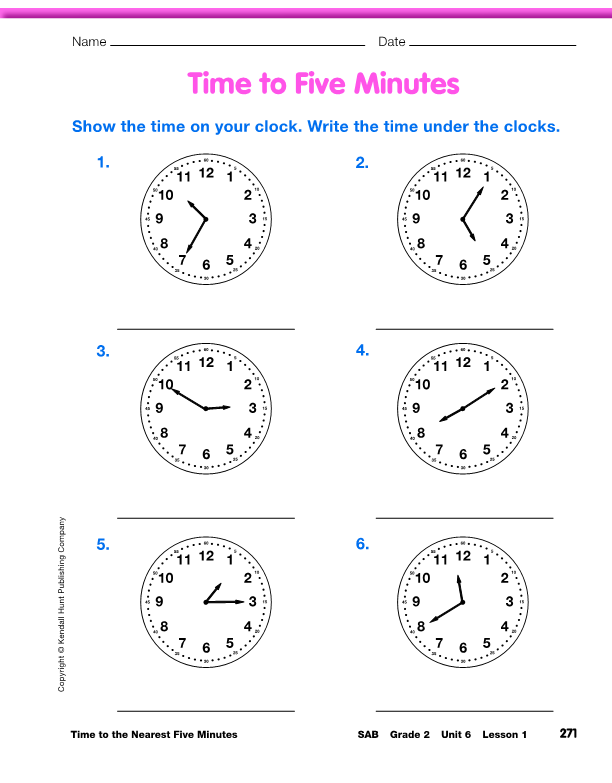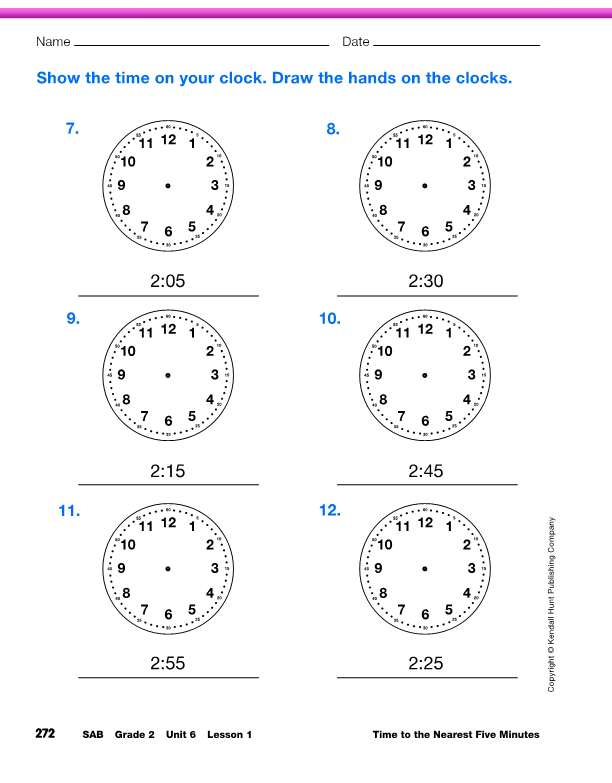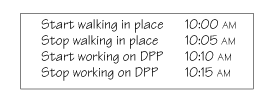Continue by asking students:
- How many minutes are in an hour? (60)
- What can you do in about an hour? (Possible response:
Math class is about an hour.)
- How many minutes are in a half an hour? (30)
- What can you do in 30 minutes? (Possible response: I
watch my favorite TV show for about 30 minutes.)
- What can you do in one minute? (Possible response:
wash my hands)
- Do you think 5 minutes is a long or short amount of
time? (Responses will vary.)
- I wonder what we could do in class for 5 minutes.
- Let's make a list of things we could do in 5 minutes.
[Record students' ideas on the board.]
Have students choose two of the activities they suggested
to perform. For instance, they can work on DPP items, write in
their journals, or walk in place for five minutes. Before
students begin the first activity, have them look at the
classroom clock and then set the time on their individual clocks.
After students have completed the activity, have them look at the
class clock to see how the minute and hour hands have moved and
then move the hands on their clocks to match. Write and label the
times for each on the board as shown in Figure 4.
Ask questions similar to the following. The answers are
based on starting the activity at 10:00.
- Now do you think 5 minutes is a long or short amount of
time?
- Can you describe the movement of the hands on the
class clock? (The hour hand did not move much at all. The
minute hand moved from the blue 60 to the blue 5. See Content
Note.)
- After five minutes have passed, where is the hour hand
pointing? (10)
- After five minutes have passed, what blue number is
the blue minute hand pointing to? (5)
- Which hand moved the most? (the blue hand, or minute
hand)
- How would you say the time? (10:05, or five minutes
past ten)

An analog clock uses at least two distinct scales to show
the time. One scale represents the hours and is divided into 12
units. The other scale represents the minutes and is divided
into 60 units. The minutes on the demonstration clock are shown
along the outside edge of the clock face. Each mark represents 1
minute with numeric markers displayed every 5 minutes. As
students identify the position of the minute hand on the clock
face, make sure they are using the scale that relates to minutes
passed rather than the scale that indicates the hour.
Have students perform the next 5-minute activity. Repeat
these questions after the activity to draw students' attention to
the relationship between the hour hand and the minute hand as
five minutes pass.
To reinforce the concept, show 10 o'clock on the
demonstration clock. Move the minute hand around the clock and
ask students to count by fives as the minute hand stops every
five minutes. Have students note the movement of the hour hand as
the minute hand moves 60 minutes around the clock in 5 minute
intervals.
- What happens to the red hour hand as the blue minute
hand moves 60 minutes around the clock? (The red hour hand
moves from 10 to 11.)
Move the minute hand from 10:00 to 10:05 and ask:
- How many minutes past the hour is it? (5 minutes)
- How do you write the time? (10:05)
Move the minute hand to 10:10. Ask:
- How many minutes past the hour is it? What blue number
is the minute hand pointing to? (10 minutes, 10)
- How many groups of five minutes have passed? (2)
- Where is the hour hand? (a little past the 10)
- How do you write the time? (10:10)
Continue moving by 5-minute intervals and asking questions
until you reach the 60-minute mark. Make sure that students note
that the hour hand has now moved from 10 o'clock to 11 o'clock.
- How many minutes have passed? (60 minutes)
- What happened to the red hour hand? (It moved to the
next number, 11.)
- What does that mean? How much time has passed? (1 hour
or 60 minutes)
- What happened to the blue minute hand? (It moved from
60 all the way around the clock back to 60.)
The idea is to have the students sense the proportional
movement of the hour hand to the minute hand—as the minute hand
moves a fraction of the way around the clock, the hour hand moves
the same fraction of the way from one number to the next. To
assist students in sensing this, ask them about how the hands
move in a half hour, since students are more familiar with half
hours.
Move the minute hand to show 10:30.
- Where is the red hour hand now? (It is halfway between
the red 10 and the red 11.)
- What time is the clock showing? (10:30)
- Where is the blue minute hand? How far around the
clock has it moved since 10:00? (The minute hand is at the
blue 30. It moved halfway around the clock.)
- How many minutes have passed? (30 minutes)
- How many minutes are in an hour? (60 minutes)
- How many minutes in a half hour? (30 minutes)
- So, when it is 10:30, the hour hand and the minute
hand are both halfway to showing the next hour. We can say it
is half past ten.
Give students a few more times to the nearest five minutes
such as 4:15, 4:20, and 4:35 to practice modeling on their
individual clocks. Have them position the hands and then say what
time the clock is showing. As they work, help students tell the
times by finding the hour and then moving the minute hand in
five-minute increments around the clocks and counting by fives.
Have student volunteers write the times on the board.
Assign the Time to Five Minutes pages in the Student
Activity Book. Tell students to use their clocks to help them
solve the problems.
Use the Time to Five Minutes pages in the Student Activity
Book to assess students' abilities to read and write time to the
nearest five minutes [E9].

















